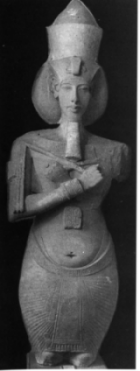An Egyptian pharoh (1380-1362 BC), the predecessor of Tutankamen, and husband of Nefertiti, Akhenaton radically revised the Egyptian religious world by instituting a unique form of monotheism. His innovation temporarially ushered in a period of artistic freedom an innovention in Egypt known as Amarna Art
Amenhotep IV ruled at the height of Egypt's empire. He is remembered for combining the hundreds of deities worshipped in ancient Egypt into one overarching deity -- Aton Ra, a sun deity. Amenhotep then changed his own name to "Akhenaton" -- or servant of Aton. His radical change in religion was a direct challenge to the priestly caste. Priests were chosen by status at birth, and were guaranteed incredible power as the spokesmen (and women) of the gods. When Akhenaton declared Aton-Ra as the supreme god, he also declared that he himself was the sole spokesman of Aton-Ra. The priests suddenly found themselves out of favor, out of power, and effectively out of a job. They were not happy. Akhenaton, on the other hand, had effectively consolidated his power. The centralization of power, combined with a weakening of the age-old superstition, produced a boom in art and creativity known as Amarna Art.
 An official statue
of Akhenaton as king.
An official statue
of Akhenaton as king.